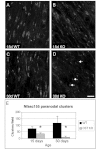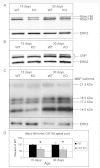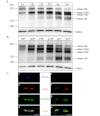Novel forms of neurofascin 155 in the central nervous system: alterations in paranodal disruption models and multiple sclerosis
- PMID: 20129933
- PMCID: PMC2822635
- DOI: 10.1093/brain/awp341
Novel forms of neurofascin 155 in the central nervous system: alterations in paranodal disruption models and multiple sclerosis
Erratum in
- Brain. 2011 Apr;134(Pt 4):1250
Abstract
Stability of the myelin-axon unit is achieved, at least in part, by specialized paranodal junctions comprised of the neuronal heterocomplex of contactin and contactin-associated protein and the myelin protein neurofascin 155. In multiple sclerosis, normal distribution of these proteins is altered, resulting in the loss of the insulating myelin and consequently causing axonal dysfunction. Previously, this laboratory reported that mice lacking the myelin-enriched lipid sulphatide are characterized by a progressive deterioration of the paranodal structure. Here, it is shown that this deterioration is preceded by significant loss of neurofascin 155 clustering at the myelin paranode. Interestingly, prolonged electrophoretic separation revealed the existence of two neurofascin 155 bands, neurofascin 155 high and neurofascin 155 low, which are readily observed following N-linked deglycosylation. Neurofascin 155 high is observed at 7 days of age and reaches peak expression at one month of age, while neurofascin 155 low is first observed at 14 days of age and constantly increases until 5 months of age. Studies using conditional neurofascin knockout mice indicated that neurofascin 155 high and neurofascin 155 low are products of the neurofascin gene and are exclusively expressed by oligodendrocytes within the central nervous system. Neurofascin 155 high is a myelin paranodal protein while the distribution of neurofascin 155 low remains to be determined. While neurofascin 155 high levels are significantly reduced in the sulphatide null mice at 15 days, 30 days and 4 months of age, neurofascin 155 low levels remain unaltered. Although maintained at normal levels, neurofascin 155 low is incapable of preserving paranodal structure, thus indicating that neurofascin 155 high is required for paranodal stability. Additionally, comparisons between neurofascin 155 high and neurofascin 155 low in human samples revealed a significant alteration, specifically in multiple sclerosis plaques.
Figures








Similar articles
-
Neurofascins are required to establish axonal domains for saltatory conduction.Neuron. 2005 Dec 8;48(5):737-42. doi: 10.1016/j.neuron.2005.10.019. Neuron. 2005. PMID: 16337912
-
In vivo deletion of immunoglobulin domains 5 and 6 in neurofascin (Nfasc) reveals domain-specific requirements in myelinated axons.J Neurosci. 2010 Apr 7;30(14):4868-76. doi: 10.1523/JNEUROSCI.5951-09.2010. J Neurosci. 2010. PMID: 20371806 Free PMC article.
-
Disruption of neurofascin localization reveals early changes preceding demyelination and remyelination in multiple sclerosis.Brain. 2006 Dec;129(Pt 12):3173-85. doi: 10.1093/brain/awl290. Epub 2006 Oct 14. Brain. 2006. PMID: 17041241
-
Anti-neurofascin autoantibody and demyelination.Neurochem Int. 2019 Nov;130:104360. doi: 10.1016/j.neuint.2018.12.011. Epub 2018 Dec 22. Neurochem Int. 2019. PMID: 30582947 Review.
-
Organisation and control of neuronal connectivity and myelination by cell adhesion molecule neurofascin.Adv Neurobiol. 2014;8:231-47. doi: 10.1007/978-1-4614-8090-7_10. Adv Neurobiol. 2014. PMID: 25300139 Review.
Cited by
-
Focal loss of the paranodal domain protein Neurofascin155 in the internal capsule impairs cortically induced muscle activity in vivo.Mol Brain. 2020 Nov 23;13(1):159. doi: 10.1186/s13041-020-00698-y. Mol Brain. 2020. PMID: 33228720 Free PMC article.
-
m6A mRNA Methylation Is Essential for Oligodendrocyte Maturation and CNS Myelination.Neuron. 2020 Jan 22;105(2):293-309.e5. doi: 10.1016/j.neuron.2019.12.013. Epub 2019 Dec 31. Neuron. 2020. PMID: 31901304 Free PMC article.
-
Possible Combined Central and Peripheral Demyelination Presenting as Optic Neuritis, Cervical Myelitis, and Demyelinating Polyneuropathy with Marked Nerve Hypertrophy.Intern Med. 2018;57(6):867-871. doi: 10.2169/internalmedicine.7153-16. Epub 2018 Mar 15. Intern Med. 2018. PMID: 29540658 Free PMC article.
-
Microglial process convergence on axonal segments in health and disease.Neuroimmunol Neuroinflamm. 2020;7(23):23-39. doi: 10.20517/2347-8659.2019.28. Epub 2020 Mar 21. Neuroimmunol Neuroinflamm. 2020. PMID: 34007863 Free PMC article.
-
Sphingolipid Players in Multiple Sclerosis: Their Influence on the Initiation and Course of the Disease.Int J Mol Sci. 2022 May 10;23(10):5330. doi: 10.3390/ijms23105330. Int J Mol Sci. 2022. PMID: 35628142 Free PMC article. Review.
References
-
- Arvanitis DN, Min W, Gong Y, Heng YM, Boggs JM. Two types of detergent-insoluble, glycosphingolipid/cholesterol-rich membrane domains from isolated myelin. J Neurochem. 2005;94:1696–710. - PubMed
-
- Bae JS, Yang L, Rezaie AR. Lipid raft localization regulates the cleavage specificity of protease activated receptor 1 in endothelial cells. J Thromb Haemost. 2008;6:954–61. - PubMed
-
- Basak S, Raju K, Babiarz J, Kane-Goldsmith N, Koticha D, Grumet M. Differential expression and functions of neuronal and glial neurofascin isoforms and splice variants during PNS development. Dev Biol. 2007;311:408–22. - PubMed
-
- Bhat MA, Rios JC, Lu Y, Garcia-Fresco GP, Ching W, St Martin M, et al. Axon-glia interactions and the domain organization of myelinated axons requires neurexin IV/Caspr/Paranodin. Neuron. 2001;30:369–83. - PubMed
Publication types
MeSH terms
Substances
Grants and funding
LinkOut - more resources
Full Text Sources
Medical

